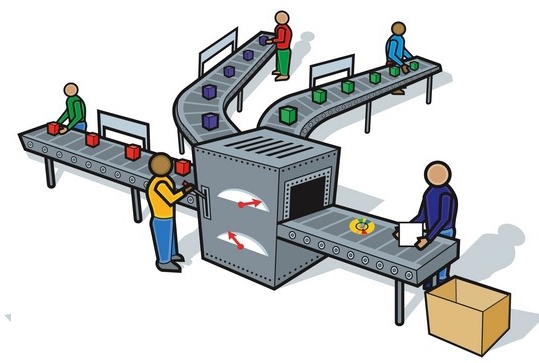Commodity production forms the basis of almost any modern economy. Their essence can be understood in a variety of contexts - historical, economic, social. Commodity production involves activities that can constantly change, improve, and be adjusted from the outside in someone else's interests. A correct understanding of their essence is an important condition for building a successful business and constructive partnership, if we talk about entrepreneurial activity. A correct interpretation of this concept is a significant factor in the conduct of a competent policy of economic development, if it comes to government tasks. What are the common approaches among Russian researchers to understanding the specifics of commodity production? What are the main historical stages in the emergence of the relevant economic categories?
What is a product?
Speaking about what is commodity production, commodity circulation, special attention should be paid to understanding the essence of the main subject of commercial communications under consideration. What is its specificity?
The term “product” can be understood in different ways. Most often, it means a certain product of labor, for example, a material thing, service, creativity or intellectual development, which was created by a manufacturer (developer, craftsman, programmer), mainly to satisfy the needs of other people through sale or exchange for another.

The noted property of the product — social orientation — predetermines the emergence of its consumer value. Depending on the specific conditions of sales, it may be adjusted due to market factors.
It is worth paying attention to one remarkable nuance. Commodity and commodity production are phenomena that are traditionally regarded as related to the commercial sphere. That is, from an economic point of view, a certain product must either be sold or exchanged. If it is given or given as a prize, then at the time of transfer of one person to another, the product ceases to be.
In this regard, there are discussions among researchers about whether to consider as a product, for example, a product given as a gift to the buyer by the store when purchasing another (as an option, the same scheme “one bought - the second for free”). On the one hand, the corresponding product is a gift, and therefore cannot be considered as a product. On the other hand, it is transmitted to a person in the context of commercial activities, and without the acquisition of the first product his delivery would not have taken place. Some researchers believe that in this case it is advisable to consider both products as a single, complex product, thus consisting of two components.
Goods and labor
The development of commodity production to a certain extent depends on labor indicators, which are invested by a person or group of people in the production of certain products. With the improvement of factory technologies and handicraft tools, the cost of products can significantly decrease, their competitiveness can grow. One and the same product can be manufactured in different ways, and in terms of the amount of labor investment, the same products can vary greatly.

Social production
Researchers distinguish such an economic category as social commodity production.What is its specificity? First of all, it is worth noting that this term can be interpreted in different ways.
So, there are socialist concepts of understanding social commodity production. In accordance with them, the process under consideration is the creation of material goods that are not intended to be launched into commercial circulation. The main task in the socialist economy is to correctly distribute the corresponding product. Moreover, people who personally provide commodity production receive money for their work. Thus, the cost of their products correlates with the labor factor, the significance of which we noted above, but at the same time does not fully meet the criterion of commercial orientation of goods.
Another interpretation of the term in question involves its use to indicate the process of product release in the order of consolidation of entrepreneurs. For example, in cartel format. Many economists see this form of business communication as a form of monopoly. Of course, in many cases, cartels are established precisely with the aim of gaining market superiority by several agreed companies.
But such associations in some cases contribute precisely to the growth of competition and, as a consequence, the quality of goods supplied for commercial circulation. This may be due to the fact that the “monopolists”, having dispersed the demand in the market, unwittingly stimulate the activity of small businesses, which, in principle, in some cases can organize competitive production and occupy their own niche.

There is also a historical interpretation of the term “social commodity production”. By this, some researchers understand the early forms of the joint organization of labor, possibly characteristic of societies even before the emergence of market relations as such. People, uniting in small communities, thus produced goods adapted for subsequent exchange or sale, but a significant part of the corresponding products was still intended for consumption within a localized society.
Correlation of natural and commodity production
Commodity production is closely adjacent to another form of management - subsistence production wealth. Therefore, to begin with, we will consider how these two concepts relate.
Natural production historically preceded commodity. It is characterized by the release of labor products, which are intended for consumption by those who produced them, or by its immediate environment. Sometimes the corresponding material goods can be exchanged. The economy of states in historical periods when subsistence production prevailed consisted of a large number of relatively closed economic communities.
Gradually, product release technologies improved, people began to have opportunities to release a large number of resources that could be sold or profitably exchanged. Associated with this is the emergence of commodity production. Of course, some of its elements could also be observed at a time when, mainly, traditional means of producing products were available to people.
The first forms of commodity production appeared, for example, after the emergence and spread among different peoples of the world of the concepts of statehood and close to them. Some international relations began to take shape, when each of the parties could offer another competitive product. With the improvement of product release technologies, such communications became more intense.

When the conditions of commodity production in terms of people gaining access to necessary tools became sufficiently widespread, the corresponding type of management became the main one in national economies.But the appearance of commodity production was due not only to technology, but also to other reasons. Let's consider them in more detail.
Factors of the appearance of commodity production
Modern researchers identify the following key conditions for the emergence of commodity production: the social division of labor, the emergence of isolated entities of economic activity.
Regarding the first, the corresponding conditions were formed in the rather early historical periods of the development of mankind - approximately when cattle breeding became a type of economic activity, isolated from agriculture. The social division of labor became more pronounced as new branches of human activity appeared. Among the most notable events that directly influenced its dynamics is the selection of craft from agricultural activities.

After that, the economic laws of the formation of new branches of human activity began to work. That is, people, taking advantage of technological advances, the exchange of experience with others, the emergence of new markets, began to actively develop the production of increasingly complex products. There were masters who could better cope, relatively speaking, with the release of metal, wood, clay products, as a result of which separate varieties of production were formed.
With the advent of states and the formation of various political and social institutions, international partnership in terms of economic activities became more intense. The division of labor has become a trend on a global scale. Some states have adapted to the production of high-tech goods, while others have begun to export raw materials. Countries have emerged that have become leaders in the provision of banking and financial services.

The division of labor is a phenomenon characterized by widespread prevalence in modern economies. It can be observed both within the global economic system, and at the scale of a single enterprise. Some researchers believe that the social division of labor coincided approximately with the time trade emerged as a separate branch of human activity.
The importance of private property
Commodity production was formed, therefore, as a result of the emergence of markets in which manufacturers of some products could receive others, released, as an option, in another state. In turn, the type of economic activity under consideration could not have appeared outside the institution of private property. For a long time, mankind developed on community principles. Together, people produced these or those products, were engaged in construction, and carried on trade. But as soon as the institution of private property arose, each person got the opportunity to produce and offer his own product to the market. Which, moreover, could be better than that produced by joint efforts. Therefore, full-fledged commodity production arose only after each participant in the trade exchange got the opportunity to become a separate, independent of the immediate environment, entity of economic activities.
Signs of commodity production
Consider the key features that characterize the type of economic activity under consideration. These include the actual production of products under the conditions of a developed system of social division of labor, in which each producer of the goods can begin to produce those items that he considers necessary and can deliver to the market.
Another characteristic that characterizes commodity production is the presence of quality criteria for a product. A person present in the market must ensure the competitiveness of the products offered. He produces goods not only for himself and his inner circle, but also for other people.In this sense, each product unit must meet certain quality criteria. Initially, they were very arbitrary, later standards were developed that were recommended to be followed by manufacturers of goods, and in some cases they were directly prescribed (in fact, a similar situation is observed in many industries today, when GOSTs work).
Another criterion characterizing the essence of commodity production (market participants exchange products), direct or indirect, is realized when money is used, based on the comparability of production costs for the production of each product. That is, the relevant legal relations suggest that the seller must offer the buyer goods at a reasonable cost. In turn, the second, most likely, will decide on the acquisition of the appropriate product, based on economic feasibility.
Some researchers consider it necessary to consider in a single context commodity production and the market as an environment for the commercial exchange of labor products. It should be characterized by open access for entrepreneurs, provided, in turn, by social institutions. In some cases, the possibility of the presence on the market of business entities may be regulated by the state. Moreover, similar phenomena can also be observed in highly developed market traditions in a particular country or region of the world.
Thus, the conditions for the emergence of commodity production can be supplemented by the need to bring the national or international market to the form that will be compatible with the intensive process of buying and selling various products from an unlimited number of manufacturers.
There are sometimes discussions among economists on whether the market in which the corresponding production activities are carried out must have a sufficiently large capacity, at least capable of ensuring competition between suppliers of products to be sold on the market. There is a version that goods and commodity production under monopoly or insufficient market capacity cease to fulfill their main macroeconomic function, which is to ensure the competitiveness of the economic system - the state or the local territorial community.
Commodity Production Models
Consider the models in which commodity production can be represented. The reasons for their classification are many. Modern researchers distinguish the following main types of relevant business processes: simple commodity production, production in free competition, production in an organized market. We study their specifics.
Simple commodity production is characterized by very small volumes of output, often it is made by one person. A similar type of economic activity could most often be observed in the historically early stages of the development of market relations. However, today it remains relevant: often a very high level of production activity is shown by individual entrepreneurs working independently or in a small team.

Production in a competitive market is characterized by unlimited access to commercial activities, which are open to any business entities. This type of commodity production involves the use of wage labor. An entrepreneur is usually involved in managerial work in his factory.
The most commercially active environment in which commodity production can take shape is the economy of an organized market.It involves a very detailed division of labor, the emergence of a wide variety of products on the market, a very high level of competition between suppliers of products. Active communication between market entities may lead to the occurrence of crisis phenomena, such as overproduction. Therefore, the state plays a significant role in the economies of an organized market. By issuing relevant legal acts, the government necessarily regulates business processes. Most economic systems in developed countries are built precisely in an organized market.
The specifics of simple commodity production
Simple commodity production is characterized by some distinctive features. For example, the means of release of goods, tools are, as a rule, owned by those people who directly produce products. In the second and third models of the organization of production - the corresponding resources, as a rule, are in the possession of the employing company. The same can be said, in fact, about the product. In simple production, a product produced by a craftsman becomes primarily his property. In the second and third systems, it falls into the possession of the employing company. A similar pattern can be observed with respect to labor. How? The fact is that with simple commodity production, the right to dispose of one’s time and labor completely belongs to the person who produces the product on his own. In the second and third models, the employer has corresponding preferences. At least, she has the right to manage the personal time of the person who releases the goods, within the working hours of the contract.
Some researchers also believe that the difference between simple production, competitive and implemented in an organized market, is that in the first case, the main motive of the person making the product is to satisfy their own needs. With the second and third models - making a profit.
Production factors
Consider the aspect of commodity production factors. In this case, we mean conditions, phenomena and processes that directly affect the release of products. Among the key factors in question:
- method or technology for the release of goods;
- openness and capacity of markets;
- labor costs.
Regarding the method of release of goods, it can be considered a determining factor in the intensity of production. The more technologically advanced the factory, the larger, as a rule, the amount of product the entire enterprise, workshop or individual specialist can deliver to the market in relation to a given time interval. The production method may also affect the cost of the product.
The factor under consideration is in close correlation with labor costs. A more technological production of goods, as a rule, predetermines a smaller volume of labor investments in the production of one unit of output. At the same time, labor costs can also be considered as a completely separate factor.
The fact is that the cost of attracting workers to an enterprise can vary greatly depending on the market situation, if, of course, we are talking about a capitalist economic system. In some cases, there may be a shortage of personnel in production, as a result of which the company will have to bear the additional costs associated with training specialists or attracting new personnel by increasing salary offers.
Accessibility and market capacity are the most important factors of production. The release of goods is advisable as long as they can be the subject of commercial activities, while they will be bought, or until the company has access to certain markets.








